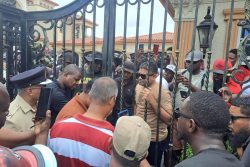A very wise woman, who also happened to be my mother, once told me: “If you know something good or hear something good about somebody, you should pass it on.” Today I’m doing as instructed by telling you about a few gems I stumbled on recently.
 I’m not that big a basketball fan (the American construction would be “…not that big of a basketball fan.” Strange.) but there’s an American television series called ‘Open Court’ that is probably the most entertaining sports programme on the tube. It’s all talk, minimal footage of plays, with 8 or so of the best who ever played in the NBA, speaking spontaneously and candidly and at length – not just sound bites. Reggie Miller, Isaiah Thomas, Grant Hill, Charles Barkley, Chris Webber, Steve Kerr, Dennis Scott, Shaq, John Starks, are some of the names, and they’re deep inside the sport giving you revealing insights you would never otherwise hear on a range of intriguing topics: the best “big man” ever; what makes a “great player”; the impact of stars such as Isaiah Thomas and Magic Johnson interacting with college players; the role of neighbourhood
I’m not that big a basketball fan (the American construction would be “…not that big of a basketball fan.” Strange.) but there’s an American television series called ‘Open Court’ that is probably the most entertaining sports programme on the tube. It’s all talk, minimal footage of plays, with 8 or so of the best who ever played in the NBA, speaking spontaneously and candidly and at length – not just sound bites. Reggie Miller, Isaiah Thomas, Grant Hill, Charles Barkley, Chris Webber, Steve Kerr, Dennis Scott, Shaq, John Starks, are some of the names, and they’re deep inside the sport giving you revealing insights you would never otherwise hear on a range of intriguing topics: the best “big man” ever; what makes a “great player”; the impact of stars such as Isaiah Thomas and Magic Johnson interacting with college players; the role of neighbourhood
pickup games in developing skills; the personalities and quirks of NBA and NCAA coaches; the players with the best moves, and how they learned them; the process of winning; the culture of the game (Isaiah Thomas is profound on this); the locker room; the funniest players; the best dream team; and on and on. It’s enthralling stuff, simply done but so compelling because it is coming from a group of renowned basketball icons, and you don’t even have to know much about basketball to enjoy it. I stumbled on the show totally by accident, but it is delicious viewing, often hilarious, and along the way you see what solid people, purely as people, many of these players are. I get it as part of my E-Networks slate here, but you can catch it online.
It struck me watching ‘Open Court’ how wonderful it would be to have a similar TV programme on cricket featuring our own icons talking about the game from the inside – the colonial era; factors behind the winning years; the fastest bowler we ever produced (Charlie Griffith?), and
the most talented (Malcolm Marshall?); the Lawrence Rowe evaluation; the many funny incidents; the behind-the-scenes tactics of various coaches; the effect of the Kerry Packer era; the legendary jokes about Sobers, Kanhai, Stephen Camacho, Lara, etc. From personal knowledge, I know players such as Michael Holding, Joel Garner, Curtly Ambrose and Desmond Haynes will
have us on the floor laughing at one point, and then marvelling at their understanding of the game, and of mankind, at another. (One caveat: it goes without saying that we would have to keep the WICB very far from this project; the players may pull out of the show before the thing even begins.)
In another fortuitous accident, involving an email from a close friend, I came upon this unbelievable documentary about Peru where a bridge at a place called Q’eswachaka is built over a 70-foot canyon completely by hand by the local people. What is most remarkable of all is that the bridge is made entirely of grass, nothing but grass, and it is constructed by the people from the two communities on either side of the bridge using traditional techniques going back to the time of the Incas. They use a local long grass called Q’oya which is harvested, dried and then woven together into long cords which are then twisted to form ropes about 2 inches thick. Many of these ropes are then braided together to make the robust main cables that will be used to form the floor of the bridge and for the handrails running along on either side. On the hillside above the canyon, 30-40 men in a line pull on the cables to take out all the slack and then, using the old bridge, they run the new main cables across the canyon and anchor them (4 cables for the base; 2 for the handrail) to huge rock abutments on the two sides of the river. Starting from one side, the builder, Victoriano Arizapana, using more grass rope, then weaves together the 4 cables to the form the deck of the bridge. He works from one side, while another craftsman works from the other side, and they meet in the middle. More grass rope goes into a weave connecting the handrails to the deck to create an enclosure that makes for safe walking for 20-30 people from one side to the other. The entire job is done in 3 days with no nails, no bolts, no concrete, no machinery; just grass, human hands, muscle power and copious courage. Since it’s grass, however, the bridge only lasts for a year, so every 12 months the job has to be done all over again from scratch. Think about it: using nothing but grass these Peruvian peasants construct a safe functional bridge in 3 days, and they repeat the job every 12 months. By comparison, with bags of money, a barrage of equipment, and a host of experts, we can’t even produce a proper cricket pitch at the Stadium – and we’ve been at it for 7 years.
Finally, I’m steering you to a video of a speech that a friend sent me that I implore you to watch. It is by Dr Shashi Tharoor, former Indian government minister and MP, and author of several books. He was one of the presenters in a recent Oxford Union panel debating the topic of
Britain possibly paying reparations to her former colonies for the excesses of colonization. Not a name I was familiar with, Dr Tharoor is an example of the heights to which someone can reach in delivering the spoken word. Working almost completely from memory, he made a brilliant case in about 16 minutes that Britain should indeed be paying India reparations, and he did it in a seamless discourse that combined history, humour, sarcasm and judicious use of data flawlessly. The man was simply superb. Don’t take my word for it; see for yourself a master at work; simply locate YouTube and go to “Dr Shashi Tharoor MP – Britain Does Owe Reparations.”
You’ll want to thank me afterward, so in advance, “You’re welcome.”







